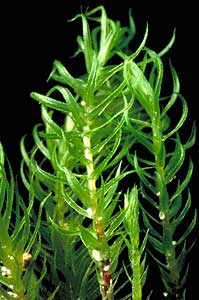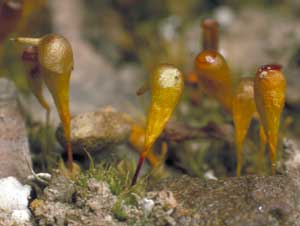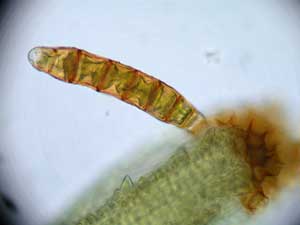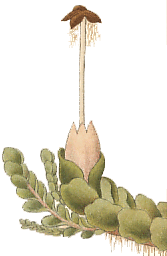
Reproduction & dispersal
Bryophytes may reproduce both sexually and vegetatively. Sexual reproduction involves the mixing of the genes of two parents, with the potential to produce new plants that differ, genetically, from each parent. In vegetative reproduction, there is no such mixing and each new plant is derived from just one parent plant.
This introductory page serves as a brief overview of the major points of sexual and vegetative reproduction in bryophytes. There are much longer discussions of each form of reproduction and there are links to those discussions in the following text. Additionally, there's a very brief account of dispersal methods near the end of this page but, again, with a link to a much longer account.
In the SEXUAL VS. VEGETATIVE SECTION you'll find a discussion about the different roles and strengths or weaknesses of sexual and vegetative reproduction. That section assumes you've read the more detailed accounts and not just this page.
Sexual reproduction
In flowering plants the flowers are essential in the sexual reproductive cycle, with the pollen (the male gametes) from one flower typically being carried to another by some agency, most commonly wind or insects. Once the pollen has been deposited it will fertilize the eggs in the receiving plant. Bryophytes have neither pollen nor flowers and rely on water to carry the male gametes (the sperm) to the female gametes (the eggs). The spore capsules are produced after the sperm have fertilized the eggs. Hence the spores are part of the sexual reproductive cycle.
The gametes are produced on what’s called the gametophyte. In mosses and leafy liverworts the stems and leaves make up the gametophyte. In hornworts and thallose liverworts the gametophyte is a flattish sheet ![]() . A spore capsule is part of the sporophyte, which develops from a fertilized egg. In some species the fertilized egg will produce just spore capsules whereas in others fertlized eggs will also produce a supporting stalk for the spore capsule. In the former the capsule is the whole sporophyte, whereas in the latter the stalk (called a seta) and the capsule make up the sporophyte. A sporophyte is always attached to a gametophyte, from which it draws nutrients while developing. The termination “-phyte” means “plant”, so the gametophyte is the “gamete plant” and the sporophyte is the “spore plant”. There's more about sporophyte structure in the SPOROPHYTE DEVELOPMENT SECTION.
. A spore capsule is part of the sporophyte, which develops from a fertilized egg. In some species the fertilized egg will produce just spore capsules whereas in others fertlized eggs will also produce a supporting stalk for the spore capsule. In the former the capsule is the whole sporophyte, whereas in the latter the stalk (called a seta) and the capsule make up the sporophyte. A sporophyte is always attached to a gametophyte, from which it draws nutrients while developing. The termination “-phyte” means “plant”, so the gametophyte is the “gamete plant” and the sporophyte is the “spore plant”. There's more about sporophyte structure in the SPOROPHYTE DEVELOPMENT SECTION.
A germinating spore produces a new gametophyte. Each spore has a single set of chromosomes and so is a haploid entity. In each cell of the gametophyte that develops from a spore there is just a single set of chromosomes so gametophytes are also haploid. The sperm and eggs are haploid. When a sperm meets and fertilizes an egg two sets of chromosomes (an equal number from each parent) are combined and the fertilized egg (or zygote) is a diploid entity. The sporophyte that develops from a fertilized egg has two sets of chromosomes in each cell and so is also diploid. In the process of spore production in the capsule haploid spores are produced by the diploid sporophyte. This happens by the process of meiosis, the same process by which animals (including humans) produce eggs and sperm, and by which the flowering plants produce eggs and pollen. You can find out more about meioisis in many print or online encyclopaedias and biology texts. For the moment the most important fact is that during meiosis genes from each parent are recombined in various ways. The haploid spores that result will often show great genetic variety, though there can be exceptions, as mentioned in the SEXUAL VS. VEGETATIVE SECTION. Once the new haploid spores are released the whole sexual reproduction cycle may start again.
In many mosses the sporophyte is commonly a capsule atop a relatively long seta ![]() though sometimes the seta can be quite short (see right) or even non-existent. In hornworts the tapering, horn-like structure
though sometimes the seta can be quite short (see right) or even non-existent. In hornworts the tapering, horn-like structure ![]() that grows out of the basal sheet is the sporophyte. In liverworts there is variation in sporophyte form. Here are photos of several liverwort capsules:
that grows out of the basal sheet is the sporophyte. In liverworts there is variation in sporophyte form. Here are photos of several liverwort capsules:
![]() leafy liverwort with stalked spore capsules
leafy liverwort with stalked spore capsules
![]() thallose liverwort with the capsule embedded in the gametophyte
thallose liverwort with the capsule embedded in the gametophyte
![]() thallose liverwort (Marchantia) with a complex umbrella-like structure that bears several spore capsules
thallose liverwort (Marchantia) with a complex umbrella-like structure that bears several spore capsules
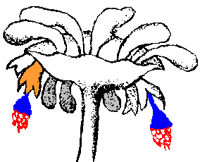 Note that in the last of the three examples just illustrated, the complex umbrella-like structure is part of the Marchantia gametophyte. What that means is that the stem holding up an umbrella is not a seta – since the umbrella stem is haploid gametophyte tissue, whereas a seta develops from a fertilized egg and is diploid. Technically the umbrella-like structure is called an archegoniophore and the diagram on the left shows the structure. Several spore capsules are produced underneath each umbrella and the capsules hang downward, each held in place by a short seta. Two mature sporophytes, with open spore capsules are shown in blue, with the seta of the sporophyte on the right being visible. Red represents the exposed spores and ELATERS of each sporophyte. An immature sporophyte is enclosed within a protective sheath, which ruptures as the expanding sporophyte reached maturity. One of the ruptured sheaves is shown in orange and some unruptured sheaves are shown in grey. The diagram has been copied from G Hahn's Die Lebermoose Deutschlands, published in 1885.
Note that in the last of the three examples just illustrated, the complex umbrella-like structure is part of the Marchantia gametophyte. What that means is that the stem holding up an umbrella is not a seta – since the umbrella stem is haploid gametophyte tissue, whereas a seta develops from a fertilized egg and is diploid. Technically the umbrella-like structure is called an archegoniophore and the diagram on the left shows the structure. Several spore capsules are produced underneath each umbrella and the capsules hang downward, each held in place by a short seta. Two mature sporophytes, with open spore capsules are shown in blue, with the seta of the sporophyte on the right being visible. Red represents the exposed spores and ELATERS of each sporophyte. An immature sporophyte is enclosed within a protective sheath, which ruptures as the expanding sporophyte reached maturity. One of the ruptured sheaves is shown in orange and some unruptured sheaves are shown in grey. The diagram has been copied from G Hahn's Die Lebermoose Deutschlands, published in 1885.
You'll find more about this topic in the SEXUAL REPRODUCTION SECTION.
Vegetative reproduction
Bryophytes can reproduce vegetatively in a variety of ways. The simplest is fragmentation. A piece that breaks off a gametophyte and then lands in a suitable habitat will grow into a new gametophyte. The breakage may be accidental, such as animal trampling or erosion leading to fragmentation of an existing bryophyte colony. However, many bryophytes have zones of weakness which promote the breakage of parts of the gametophyte, such as whole branches or perhaps just branch tips or even just parts of leaves. Such fragmentation is much more common in the leafy bryophytes than in the thallose ones.
The connecting part in a forking gametophyte may die, leading to the loss of a connection between two forks. Each of those forks now assumes an independent existence and where there was originally just one plant, there are now two. In this method of reproduction, which is found in various leafy and thallose bryophytes, the two resulting plants are still very close to each other.
Many bryophytes produce tiny, easily dispersed propagules that will germinate to produce new gametophytes. In some cases such propagules are produced in specialised structures, such as the shallow, circular cups of Marchantia ![]() . You can see tiny green balls in each cup and each such ball is called a gemma, which happens to be the Latin word for jewel. A gemma may be just a single cell or a simple aggregation of cells, rather than a well-structured feature such as a leaf or a branch tip.
. You can see tiny green balls in each cup and each such ball is called a gemma, which happens to be the Latin word for jewel. A gemma may be just a single cell or a simple aggregation of cells, rather than a well-structured feature such as a leaf or a branch tip.
Many bryophytes produce gemmae, but most don't do so in specialised structures. Rather, the gemmae grow off stems, leaves or thallose surfaces and sometimes are visible only under a microscope – in contrast to the gemmae of Marchantia, which are about a half millimetre in diameter and visible to the naked eye. This photograph shows a gemma of the moss Calymperes dozyanum. The brown, multi-celled gemma is about a tenth of a millimetre long and is attached to the apex of the leaf. In this species such leaf gemmae grow in clusters at the apices of some of the leaves. In the photo you can see a blurry, brown "cap" with a honeycomb-like appearance on the leaf apex. Initially a gemma was attached at each of those honeycomb cells. Such leaf gemmae are easily broken off and dispersed from the leaf and each is capable of growing into a new plant. Production of gemmae is fairly common in the bryophytes.
Since vegetative propagules are in effect simply parts of a gametophyte those propagules are haploid.
For more about this topic, go to the VEGETATIVE REPRODUCTION SECTION.
Dispersal
The production of spores or vegetative propagules is a critical step on the way to producing new plants. But those spores and propagules need to be dispersed. Many bryophyte spores are very small and easily wind-dispersed, potentially over fairly long distances. Water is another dispersal agent and one group of mosses even attracts insects to carry away the spores.
Vegetative propagules are generally too big to be wind-dispersed, except for rather short distances. Water, insects and larger animals have been found as carriers of vegetative propagules.
By and large, vegetative propagules are means of short-range dispersal and spores are means of long-range dispersal, but there certainly are exceptions.
There's more about this in the DISPERSAL SECTION.
![An Australian Government Initiative [logo]](/images/austgovt_brown_90px.gif)


